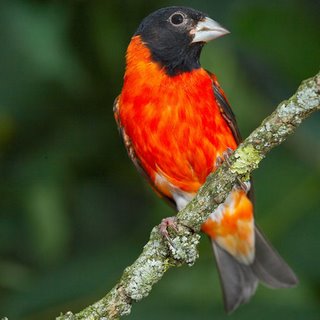
Independent, The (London), Jul 2, 2003 by TIM BIRKHEAD
The red siskin - a tiny blood-red bird of the coastal mountains of Venezuela and Colombia - has been trapped almost out of existence. Reduced to a few hundred individuals, the species was critically endangered. Now, however, a previously unknown population in Guyana has been discovered that gives the species a breathing space and, hopefully, a new lease of life.
Ever since the Spanish set foot in South America 500 years ago, the red siskin, Carduelis cucculata - known locally as cardinalito (little cardinal) - has been a popular cagebird. Avid bird-keepers, the Spanish had previously appropriated another little bird - the canary - when they took possession of the Canary Islands in the early 1400s. The canary - at that stage still a dull green little bird rather than the familiar yellow one we now know - soon became the premier cagebird. Its voice was second only to the nightingale. But the nightingale was much more difficult to keep in captivity and sang "but one short season of the year".
By comparison, the canary was a robust bird and a hearty performer. As the 16th-century naturalist Conrad Gessner noted: "It hath a very sweet and shrill note, which at one breath continued for a very long time... Many are delighted by this kind of singing." So many people were delighted by the canary's song that the bird soon became a highly prized article of trade and an important status- symbol for the rich. The Spanish were astute operators, and for nearly 200 years retained a monopoly on the canary by selling only the males and preventing anyone from breeding them.
Spanish bird-keepers also discovered that in captivity the canary would sometimes hybridise with other finches - most readily with its close relative the serin, but also with others such as the goldfinch. These mongrel birds were bursting with hybrid vigour, attractively coloured and best of all, wonderful singers. It wasn't long before the Spanish were exchanging red siskins from South America with canaries from the Canary Islands. And they soon discovered that the two species would inter-breed and produce especially attractive hybrids. The red of the siskin parent enhanced the canary's green colour to produce a little bird that looked as though it had been dipped in saffron. Not only that, the crossbred bird sang like an angel.
The red siskin and its canary hybrids were one of the Spanish empire's best-kept secrets. Across Europe, bird-keeping was ubiquitous, but bird- enthusiasts in Britain and the Continent, such as Conrad Gessner and Samuel Pepys, knew nothing of the red siskin's existence. Rather, they revelled in the songs of our native species, such as the goldfinch and woodlark.
It was not until the 19th century that the red siskin was seen outside Spanish territory. The English ornithologist William Swainson found the first one in 1820 in possession of a bird-keeper who had bought it on the Spanish Main. But even as the craze for bird- keeping swept through much of Europe during the 19th century, the red siskin remained incredibly scarce.
The Reverend Hubert Astley, a keen bird-keeper, acquired one in 1902 without knowing what it was. He wrote to the Avicultural Magazine, enclosing a watercolour sketch, asking the editor if he could identify it. He could, because red siskins were now being brought into Europe in increasing numbers. They arrived both alive and dead. Live siskins were imported as cagebirds. The dead ones were used - almost in their entirety - to adorn ladies' hats and dresses, adding a nice touch of fiery colour. The trade in plumes accounted for the lives of millions of birds of many different species, and triggered the start of what would eventually become the Royal Society for the Protection of Birds.
By the beginning of the 20th century, the canary had been well and truly transformed from its original tiny, grey-green state and now came in a huge variety of guises. Some, such as the Lancashire were huge, twice as a big as their wild ancestor. Others sported Beatle- haircut crests, while another, referred to as the Glasgow Don, had been cultivated for its serious academic stoop. Canaries also existed in a range of colours; the original green, a scaly reptilian feathering known as the Lizard, white and yellow.
But what one particular group of fanciers fantasized about was a red canary. Knowing that the Spanish successfully hybridised canaries and red siskins fired their imagination. Perhaps, by crossing canaries with red siskins, they could somehow capture those red genes, allowing them to produce a canary of the same colour.
The quest for the red canary became an obsession. It started in Germany in the early 1900s, spread across Europe to Britain, and by the 1930s it has crossed the Atlantic to America. But creating a red canary was far from easy. Siskins and canaries hybridised readily enough and, remarkably, some of their hybrid offspring were fertile when bred back to canaries. But the siskin's crimson colour was extremely elusive. The best the breeders could produce was birds of a coppery hue, sometimes orange, but not red.

